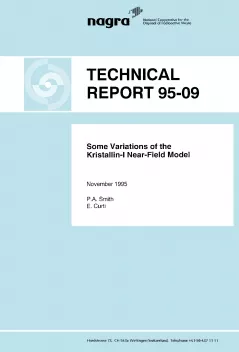
Technical Report NTB 95-09
Some Variations of the Kristallin-I Near-Field Model
The Kristallin-I project is an integrated analysis of the final disposal of vitrified highlevel radioactive waste (HLW) in the crystalline basement of Northern Switzerland. It includes an analysis of the radiological consequences of radionuclide release from a repository. This analysis employs a chain of independent models for the near-field, geosphere and biosphere. In constructing these models, processes are incorporated that are believed to be relevant to repository safety, while other processes are neglected. In the present report, a set of simplified, steady-state models of the near-field is developed to investigate the possible effects of specific processes which are neglected in the timedependent Kristallin-I near-field model. These processes are neglected, either because (i) they are thought unlikely to occur to a significant degree, or because (ii) they are likely to make a positive contribution to the performance of the near-field barrier to radionuclide migration, but are insufficiently understood to justify incorporating them in a safety assessment. The aim of this report is to investigate whether the arguments for neglecting these processes in the Kristallin-I near-field model can be justified.
This work addresses the following topics:
- Radionuclide transport at the bentonite-host rock interface: the Kristallin-I near-field model allows two possible boundary conditions at the interface. Either, (i) radionuclide concentration can be set to zero (mathematically equivalent to unlimited groundwater flow), or (ii) it can be assumed that the diffusive flux out of the bentonite is equal to the advective flux into the host rock. The second boundary condition tends to the first as the flowrate increases, since, at high groundwater flowrates, the concentration at the interface tends to zero. Steady-state calculations indicate that, for the near-field parameter values adopted in Kristallin-I, at Darcy velocities above about 10-11 m s-1, the radionuclide release to the host rock becomes flowrate-independent. However, this release is reduced by about an order of magnitude at the (smaller) Darcy velocity corresponding to the Kristallin-I Reference Case, indicating that use of the second boundary condition can substantially increase the calculated performance of the near-field.
- Canister settlement: in the near-field model of Kristallin-I, it is assumed that long-term settlement of canisters embedded in bentonite due to creep deformation is negligible. Although in reality only very small displacements are likely, steadystate calculations indicate that even large displacements would have little effect on the net release of radionuclides to the host rock, which would increase by less than 20 % for a canister sinking half way to the tunnel floor. This indicates that neglecting canister settlement in the calculation of radionuclide releases from the near-field is unlikely to result in significant underestimates of radiological consequences, even if the degree of settlement is far greater than expected.
- Chemical conditions and radionuclide transport at the glass-bentonite interface: in the near-field model of Kristallin-I it is conservatively assumed that the failed canister offers no resistance to radionuclide transport. In reality, it is likely that canister failure will be localised (in the form of a crack or a hole), and that the breached canisters will act as a barrier. A steady-state model has thus been developed to quantify the canister resistance to radionuclide transport. It is assumed that radionuclides diffuse through a thin circumferential crack (1 μm to 1 cm in width) filled with water or with bentonite. Steady-state calculations for a bentonite-filled crack indicate that the transport resistance of the crack reduces radionuclide releases by up to an order of magnitude for a 1 cm thick crack and by more than 4 orders of magnitude for a 1 μm crack. This indicates that neglecting the transport resistance of such openings gives results which err greatly on the side of conservatism. The Kristallin-I model assumes further that reducing conditions are maintained within the bentonite, in spite of the possible formation of oxidants through water radiolysis at the waste surface. Significant diffusion of such oxidants into the bentonite would locally increase the solubility limits and decrease the sorption constants of many redox-sensitive radionuclides, resulting in higher radionuclide release rates into the host rock. However, our calculations indicate that, under realistic conditions, radiolytic oxidants would not spread significantly into the bentonite. Even with highly conservative assumptions concerning the time of canister failure and the consumption of oxidants by ferrous iron in the bentonite pore water, the redox front would penetrate less than 2 cm into the bentonite.
